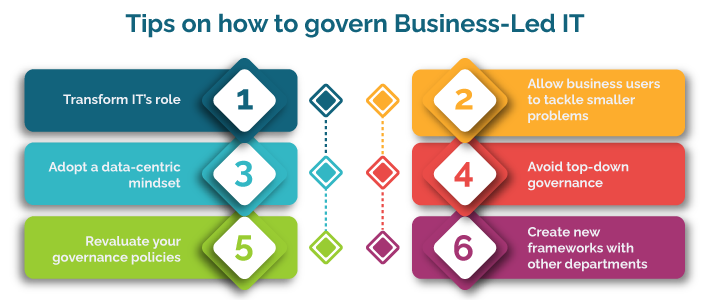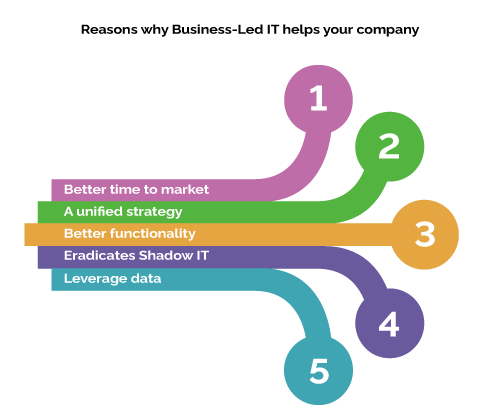22 Mar

It is estimated that IT spending is projected to total $5.1 trillion in 2024, an increate of 8.6% from 2020, according to Gartner. With an upsurge in the number of applications used by the average business user, it has become important to address the fact that these applications aren’t always vetted by the IT department. These business users might not be fully aware of the drawbacks or vulnerabilities of their new tools on an enterprise-wide scale. This is where the IT department can step in and help lead the business users in the right direction. This is called Business-Led IT.
What is Business-Led IT?
Business-Led IT refers to any technology that is purchased and used outside of the IT department or outside of the CIO’s purview. As business leaders take more decisions regarding the tools and technology to help improve productivity, they are also involving the IT department by taking inputs to better understand how the software could benefit the company on the whole.
This was previously called shadow IT and was considered a problem by the IT department as it allowed employees to use multiple services and vendors without the IT department’s knowledge which could lead to security concerns and confusing data silos. Now, however, shadow IT has been mostly accepted as a driver of innovation in companies and a method of increasing productivity and efficiency within the employees.
Business-led IT needs to be a partnership between the IT department and the business users. The problems that the business users have can be solved by tools that the IT department has in-depth knowledge about. If the IT department acts as a consultant for the business, it can get a holistic understanding of the issue and suggest cutting-edge technology or software which can efficiently and smoothly solve a problem.
What is the difference between Business-Led IT and Shadow IT?
While business-led IT also involves the purchase and usage of technology outside the purview of CIOs and IT departments just like shadow IT. But are they both the same? Well, the answer is no. While business-led IT technology is still outside CIO’s purview, with the alignment of business units and IT department, the IT department is aware of its existence and put efforts to mitigate the risks associated with using these technologies. Business-led IT is a deliberate method of distributing I&T efforts and accountability across an organization that is backed by a service-optimized IT operating model and IT governance, at the very least.
Understanding the role of the CIO
The CIO has traditionally been in charge of managing the entire IT department. The CIO oversees the maintenance and improvement of the company’s internal technology and IT infrastructure to ensure maximum productivity and the automation of complex tasks. However, with the recent surge in different tools and applications being utilized by business users outside of the IT department, the scope of the CIO has increased considerably.
In the past, the CIO was the only one who could develop strategies to leverage technology to benefit the company, however, with the amount of increased digital literacy and dexterity in employees, this role is now shared with all of the other business users in the organization. Thus, it’s more pertinent for the CIO to find ways to improve upon the current systems and workflows to become more agile, more reliable, and more profitable.
One of the main roles of the CIO is to remain updated on new technology and software in the market as well as rising technologies to ensure that the company remains on par with its competitors. These new technologies including machine learning, robotic process automation, Internet of Things, etc are cutting-edge technologies that could have a serious positive impact on the overall productivity and efficiency of the company on the whole.
The CIO needs to find a way to integrate these innovative trends into the company’s infrastructure to stay relevant. However, with multiple applications being used by business users on a daily basis, the CIO also needs to keep a close eye on these apps to prevent any data leaks or security breaches.
The CIO is also in charge of creating custom applications to help boost productivity using personalized interfaces and controls. The best practices regarding anything IT-related also need to be determined by the CIO to provide a manual or guide for business users in the enterprise. The entire IT budget is also controlled by the CIO, who gets the final say on what software or hardware can be purchased within the company.
Explore: Quixy for CIOs, CTOs and IT Leaders
Why should business leaders work closely with IT?
The tech world is currently full of different applications and vendors to fulfill various needs. This abundance of choice can lead to confusion, especially when deciding between applications that perform similar functions. While the IT department is best equipped to understand which software is best, they don’t generally have a good grasp on what the actual problem is. This is where the business users come in. Business users will always have a better understanding of the problem that they are facing, and this knowledge can help them choose the correct software or vendor for their issue.
Both parties bring different benefits to the table: the business users know their problems, obstacles, and business inside out and the IT department knows which cutting-edge technology can be adapted to solve these problems. If both these parties work together, they can identify a product or software that can solve the issue securely while incorporating newer and better technology into the system.
Understanding business goals across an enterprise can obviously be difficult due to the sheer size of the company. This is why it’s important for the IT department to be spread across business units so that they can see and anticipate future problems and have the solutions ready. It’s no longer enough for the IT department to just keeping the organization running, it also needs to encourage innovation and improvement by keeping an eye out for new technology that could increase productivity and efficiency. This can help the business leaders achieve their KPIs while keeping a technology-forward approach to the inner workings of the organization.
Explore: Quixy for Business Leaders and Managers
How can you govern Business-Led IT?
Currently, according to the Harvey Nash/KPMG CIO survey, around 63% of organizations have technology that is being managed outside of the IT department, which shows the popularity of this trend. Business-led IT can definitely help companies adapt to market changes faster and provide their customers with the exact product or service that they need.
However, Business-Led IT comes with its own risks and disadvantages. With the IT spend being split up into multiple areas of control, there may be more chances of critical information being unsecured or a potential cyber threat in the form of cyber-attacks and hacking. Hence, it’s very important for companies to have proper measures in place to help govern Business-Led IT.
Governing Business-Led IT isn’t as easy as it seems. The biggest advantage of enabling your business leaders to have a say in the technology used by their department is in driving efficiency and increasing the overall productivity of the teams. If IT steps in and takes over after a certain point, this might lead to the loss of the advantages that Business-Led IT can give them. So, it’s definitely important for companies to have a plan in place before introducing Business-Led IT as a viable solution or option to business leaders.
Here are a few tips on how to govern Business-Led IT:

1. Transform IT’s role
The IT department is surely used to stepping in and taking over when an issue appears. However, this stops the business users and leaders from getting a chance to learn and understand where the problem might be. This can lead to a deterioration of digital dexterity going forward. Instead, IT should be teaching the business users about what went wrong and how the problem can be improved. If a business user has an IT member coaching and advising them about the possible pitfalls, there’s a better chance that they will be better educated about security threats and how to secure important data.
2. Allow business users to tackle smaller problems
When it comes to the role and duties of IT, there are two types of tasks: smaller-scale problems and ideas that need to be tested as well as large-scale concepts that need to be scaled to enterprise level. The smaller-scale problems can often be tackled by finding solutions using agile methodology, consumer-grade IT, and rapid testing of MVPs.
3. Adopt a data-centric mindset
Business-Led IT heavily depends on having a strong IT infrastructure that can be utilized efficiently. Currently, data is key in all industries, and adopting a data-centric mindset by constructing an agile, reliable, and secure IT infrastructure that can protect the customer’s data could lead to accelerated growth.
Business users are most connected to the customers and clients of the company, so they are in the best position to understand what the customers need. As they try to fulfill the demands of the customers, a robust and secure IT infrastructure could prevent future security risks due to data theft or data loss. A data-centric mindset might help the IT department to plug up potential holes that could go on to cause data leaks.
4. Avoid top-down governance
If you attempt to promote business-led IT through top-down governance, there’s a higher chance that it will fail. Starting from the ground up will be a better option to help encourage collaboration amongst members and promote taking ownership of such initiatives. This will also give the employees an in-depth understanding of why this change is required as well as boost support towards this initiative on the whole.
5. Revaluate your governance policies
You also need to revamp your governance policies to include the different employees who will be a part of this initiative. Creating a holistic framework to govern business-led IT will ensure that this new concept can continue efficiently throughout the organization. This policy will also help take some of the burdens off of the IT department which would otherwise need to carefully monitor this initiative, on the whole, causing a loss of time and money.
6. Create new frameworks with other departments
As there will be many different employees from different levels and backgrounds associated with this initiative across the company, it’s important to take this into account for other decisions. Various stakeholders of different experience levels and maturity across the organization need to be communicated with before setting up further processes in departments that are related to the IT department such as compliance, legal, security, finance, procurement, audit, and other IT organizations.
Also read: Breaking down the benefits of No-Code for CEO, CIO, CISO, CFO, and Business Leaders
What measures can ensure that Business-led IT is successful in your organization?
Business-led IT might consist of a lot of decision-making amongst the leaders of the business units and the CIO and other IT employees, however, it’s equally important to have a member of the business unit who can guide the other employees.
This member can become a point of contact between the employees in the business unit and the IT department staff and will essentially have a different career path altogether. This individual will have to coordinate with the central IT team and enterprise architects as well as the people within the BU. This individual can also be put in charge of creating an inventory of the solutions being used in the BU along with a short description of the tool and how it is tailored to help solve problems.
This role will have to be developed deliberately as the individual will have to be trained regarding certain competencies such as:
- Efficiently working with IT and informing them about decisions so that they can align and integrate with existing practices while streamlining processes and data management.
- Monitors security and risk management on behalf of the business unit. Keeping an eye out for cybersecurity risks, data security threats and prevents vulnerabilities from entering the system.
- A clear understanding of the extent of their technical knowledge and knowing when to ask the IT department for help to avoid problems in the future.
- Proactively helping contribute to the growth of the digital transformation initiative within the company. Understanding the short-term and long-term goals of the company regarding digital transformation and knowing how to balance the prioritization of the two.
- Understanding the speed, scalability, and reusability of certain solutions used within the BU.
Tips to ensure successful efforts towards Business-led IT
Here are a few more tips on how to ensure that your efforts towards business-led IT in your company prove successful:
1. Promote transparency
Often, business-led IT can help reduce or eradicate shadow IT from the organization. Transparency is key to ensuring that your efforts prove successful. However, it is important to take stock of how your employees might react to the introduction of business-led IT. If you feel like instead of bringing all information to light, the employees will instead hide their actions, even more, then business-led IT might not be the correct direction for the organization at the current moment.
2. Decide upon accountability
Once the decision-making powers are split between the business unit leaders and the CIO, it will become very important to decide who is held accountable for various decisions. Even if the status quo till now has been that the CIO is accountable for all software and technical decisions, this will have to change with the change in leadership. Thus, it’s important for business leaders to take up ownership of their technical decisions and be held accountable for their actions.
3. Create a stable framework
Every project will need to be sorted into a framework to understand which projects can be undertaken by employees in business units and which need to be handled by those in the IT department. Depending on the criticality and complexity of the tasks, they can be assigned accordingly. Simple and non-critical tasks can easily be taken over by those in the business units. Simple and mission-critical tasks can also be taken over as long as they are guided by IT. However, complex and mission-critical tasks need to be handed over to the IT department entirely, to ensure that no problems occur which could bring the whole project to a standstill.
4. Negotiate for new solutions
If an individual brings up a new solution to a problem, in place of an existing solution, you need to be prepared to negotiate and understand whether this solution will be an asset or liability. The IT department and business leaders also need to reserve the right to decline this request after understanding the benefits of the product. This can help prevent further issues and dissatisfaction regarding the introduction of new tools and solutions into the current inventory.
5. Create a training program
Make sure to cater to those employees who are interested in this concept and create training programs for them to further their skills. Help them to understand every facet of technical programs including procedural considerations, risks, and legal issues to make the process smoother overall. You may also be able to find talented individuals through this program, to whom you can offer further training in a specialized area. Investing in a training-focused approach and an enterprise-wide initiative can help you further implement business-led IT in the long run.
How can Business-Led IT help your company?
Business-Led IT has slowly become a requirement to survive in today’s digital world. No longer are there separate business and technology strategies, there is simply a business strategy that is being backed by technology. This new approach has caused business users and leaders to get much more involved in the technology side of the business. However, there’s reason to believe that this is actually a good thing:

- Better time to market: Implementing smart tools and applications can help speed up the timelines of MVPs and tests while creating a new product. As the business users and leaders are aware of the exact tools that they need, IT can work as a facilitator and find these tools leading to faster timelines and improved productivity.
- A unified strategy: With the business leaders and IT experts working together, there’s a better chance of having a unified singular strategy and defined goals that both parties agree upon. This strategy can help create shared goals that can drive the business forward and accelerate its growth if determined correctly.
- Better functionality: There are many applications on the market that can help automate complex tasks or simplify workflows and this, in turn, can greatly improve productivity and job satisfaction. Legacy software and applications within the company can be upgraded and migrated into cloud-based applications, leading to better functionalities with fewer problems.
- Eradicates Shadow IT: Shadow IT is the trend of using and purchasing digital tools and technology without the permission or knowledge of the IT department. If the business users and IT department work together, the CIO can keep an eye on which tools are being used by the business leaders and teams. This can prevent security risks in the future.
- Leverage data: Business users are often directly in contact with customers and clients, and thus know exactly what they want. This knowledge is extremely important, especially with the emphasis that is placed on data today. Working closely with IT can give the business users the correct tools to leverage this data and keep the customers satisfied by resolving issues efficiently.
Empower Your Business: No-Code Revolution in Business-Led IT
Imagine a game-changing solution that puts the power in your hands – welcome to the era of business-led IT, fueled by the unstoppable force of no-code. With no coding required, you can shape your own destiny by creating custom applications, workflows, and automations, all at the speed of thought. Say goodbye to long development cycles and hello to agile innovation. Collaboration between business and IT teams reaches new heights as barriers crumble and shared goals emerge. Get ready to unlock your business potential, drive efficiency, and outpace the competition. Step into the spotlight with the no-code revolution and witness the remarkable transformation of business-led IT.
Conclusion
Business-Led IT is the way forward for many companies as developing a synergy between the business and technology side of the organization can lead to great outcomes. Both of the teams working in conjunction with each other could encourage more innovative solutions and implementation of cutting-edge technology to solve the customer’s problems. Generally, business users use cloud-based tools and applications that may help with automating repetitive tasks or increase efficiency. The IT team can help them find secure applications that can help business users with their work while avoiding vulnerabilities in terms of security.
Quixy is a no-code application that can help business users create workflows, applications, and forms in a few clicks of a button, without writing a single line of code. Don’t miss out on the chance to elevate your processes. Take the first step and get started with Quixy today.
Frequently Asked Questions(FAQs)
Q. How can businesses effectively shift towards business-led IT?
Businesses can shift towards business-led IT by fostering collaboration, providing resources, and investing in employee training. Creating cross-functional teams also helps align technology initiatives with organizational goals. Promoting autonomy and digital proficiency facilitates a smooth transition to a business-led IT approach.
Q. How does the integration of business-led IT influence organizational dynamics?
The integration of business-led IT can significantly impact organizational dynamics by empowering departments to take ownership of technology initiatives. This shift fosters a culture of innovation and collaboration as teams become more involved in shaping technological solutions tailored to their specific needs. Also, it promotes agility and responsiveness within the organization, as departments can quickly implement changes and adapt to evolving business requirements without extensive reliance on traditional IT channels. Overall, integrating business-led IT promotes a more dynamic and adaptable organizational environment.
Q. What tech advancements are crucial for supporting business-led IT strategies?
Crucial tech advancements supporting business-led IT strategies:
Empowering Business Users: Low-code/no-code platforms and self-service BI tools give business users the power to build workflows, analyze data, and make data-driven decisions, reducing reliance on IT.
Cloud & Agility: Cloud computing and SaaS solutions offer on-demand IT resources, scaling and adapting to business needs quickly.
Automation & Efficiency: Process Automation tackles repetitive tasks, while AI/ML automates decision-making for optimized processes.
Integration & Visibility: Integration Platforms break down information silos, giving a unified view of business operations.
These advancements foster collaboration between business and IT, creating a more agile and responsive technology environment.
Q. What are some examples of business-led IT?
Examples of business-led IT include:
Custom software development by business units.
Adoption of cloud-based collaboration tools.
Marketing teams use data analytics platforms.
Implementation of no-code/low-code development platforms.
Integration of CRM systems by sales teams.
Deployment of project management tools by project teams.
Adoption of employee training platforms by HR departments.
Subscribe
Login
Please login to comment
0 Comments















